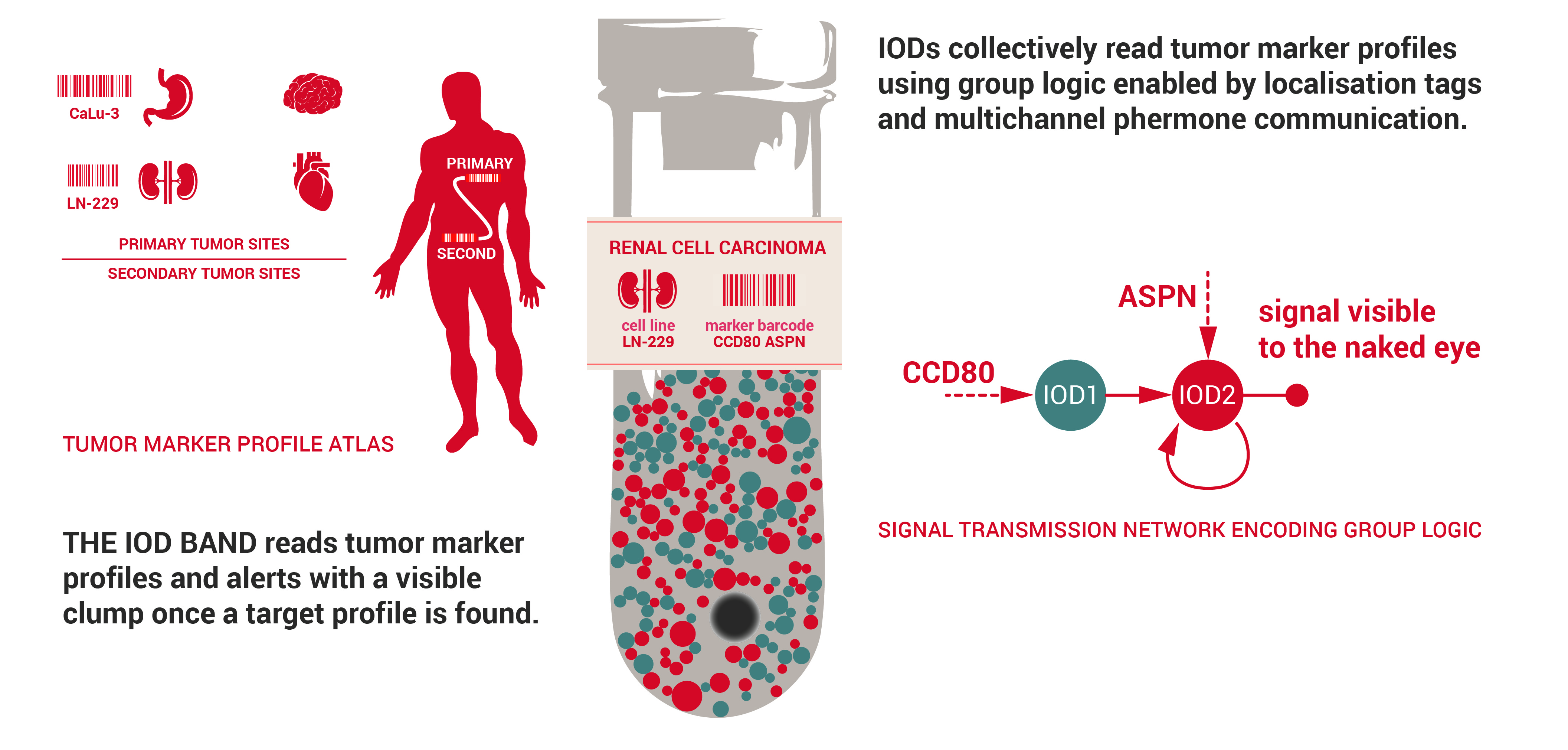Team:Czech Republic/Idea
Idea
Contents
The IOD band concept
At Team Czech Republic, we envisioned a tumor marker body atlas. A large number of tumor cell lines as well as healthy tissues of common secondary sites have well-documented surface marker profiles. A dataset of over 700 surface markers comprising of common receptors, transmembrane proteins, and channel families was processed to identify usable members with confirmed antibodies. Each cell line was then linked to a unique combination of up to three markers identified by a simple 6 or 9 digit barcode. We then envisioned The IOD Band, a marker profile probe that locates cells with target marker combinations in samples of peripheral blood.
The fundamental units of the IOD band are intelligent input/output diploid cells called IODs. An IOD is fundamentally simple comprising two modular inputs and a single modular output. The inputs are locational tags displayed on the surface and pheromones detected by orthogonally expressed receptor and signaling pathway. The inputs combine to yield locally limited cell-cell communication. Pheromones are also the IOD outputs. A rewiring of the signaling pathway transcription factor connects the inputs with the outputs. Hence, a single IOD simply detects a pheromone signal and generates an orthogonal signal in response.
High degradation rate of IOD pheromones and precisely tuned signaling thresholds limit IOD signaling to a local perimeter. Therefore, location tag facilitated IOD co-localization can switch on the pheromone-mediated communication channel. Once communication is initiated, IODs use group logic encoded within their signal transmission network to diagnose the particular marker profile. All transmission networks with similar end result are not equal in terms of robustness and efficiency. IODs may use a combination of network motifs to increase detection accuracy and decrease the number of false positives. Upon confirmation of a target maker profile, IODs initiate global cell clumping to produce a signal visible to the naked eye. Cell clumping may either be centered to the identified target or triggered between all cells.
As such the IOD band presents a clinically relevant solution to the difficult diagnostic problem. Using current technology diagnosis of marker profiles is impractical and most likely only solvable using immunofluorescent staining followed by microscopic screening, a process that takes time on the order of days. The IOD band requires no advanced instrumentation or training. Reliable designs inherently filter the samples to minimize the incidence of false positives in a broad range of working conditions. The IOD band also costs about the same as a package of yeast powder. Together, the fast processing time, the minimal processing effort, and the negligible process cost mean that the test is clinically relevant for preventive testing as well as monitoring of tumor mobility in diagnosed patients.
The IOD band concept, however, does not stop there. At Team Czech Republic we wanted to make sure anyone can optimize and update the technology. We believe that the best current engineering practices could be significantly improved if all engineering experts and not only synthetic biologists could modify the system architecture to develop reliable heuristic design rules. We also realize that no matter how complete the IOD band may be, science is constantly generating new information regarding tumor mobility and tumor mobility markers.
One of the most important design features of the IOD band is the way it is made. Each IOD variant is assembled clone-free from libraries of input haploids and output haploids. The haploid parts differ in their input receptors, location tags, and output pheromones. A designer then simply matches the desired inputs with the desired outputs and assembles the corresponding diploid using the natural process of sexual conjugation, a one-day procedure. We believe that this assembly process will speed up the engineering process, much like the breadboard did in electronic design.
We believe the process also provides a degree of modularity down to levels that are tractable with current synthetic biology methods. Each IOD comprises only a few genes and its intracellular biochemical reactions connecting the inputs to the outputs are completely isolated from the rest of the system by the cell membrane. This innovation in the engineering process may ultimately provide a framework for exploring wider applicability of the IOD concept outside of tumor diagnostics.
